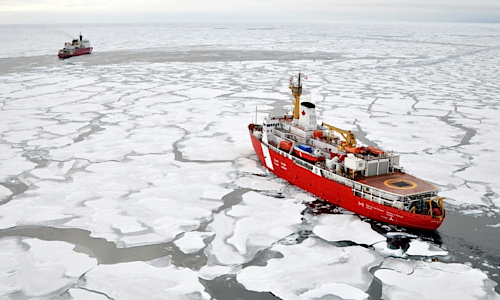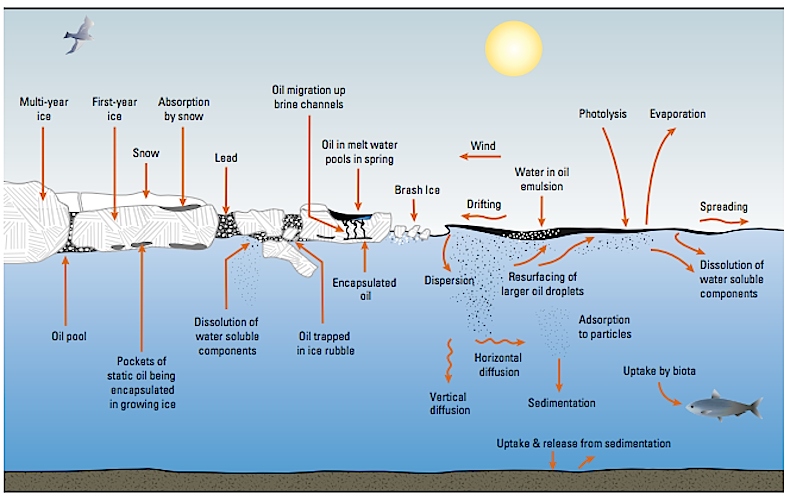
Federal Study Warns Oil Industry Nowhere Near Prepared for Spill in Arctic

The latter of these has been by far the most aggressive, having sunk around $6 billion into preliminary attempts to mount a drilling operation. As of yet, however, these have been unsuccessful.
Although Shell did not respond to a request for comment on the new report, the company’s own drilling attempts have likely done more than anything else to elucidate just how risky Arctic drilling would be—and how unprepared either companies or government agencies are to deal with those risks.
The most dramatic such instance came in Dec. 2012.
In part to escape a steep tax liability that would have gone into effect the following month, Shell decided to tow its main oil-drilling rig, the Kulluk, some 1,700 miles through winter waters, despite stringent warnings from the captain of the tow ship.
Amidst massive ocean swells, the Kulluk, reportedly laden with 150,000 gallons of fuel, eventually broke free, floating on its own before running aground in an area known to be ecologically fragile. The rig’s crew had to be rescued by the U.S. Coast Guard, which this month released a final report on the incident. The report is highly critical of Shell, castigating the company for “inadequate assessment and management of risks.”
“Vessels and the operations they conduct are growing more complex, and the risks that accompany these operations increase, whether in Alaskan waters or not,” Joseph A. Servidio, a Coast Guard rear admiral, wrote in an introduction to the report. “The failure to adequately understand, respect and not complacently assume past practice will address new risks, is critical both in practice and in company culture.”
The Kulluk was the latest in multiple operational setbacks that Shell’s Arctic attempts have experienced. The company has stated that it will not be trying again to drill in the Arctic this year, but will likely mount a new attempt in 2015.
Arctic Council Opportunity
Also in 2015, the U.S. will take over the rotating leadership position of a grouping called the Arctic Council, the most prominent multilateral attempt to coordinate a global approach to the region. Many are hoping this new leadership position could do much to influence Arctic policy, just as attention towards the region is spiking.
Indeed, interest in the Arctic Council itself has strengthened significantly in recent years, as it has become increasingly clear that climate change-related effects were quickly leading to lucrative new commercial opportunities in the Arctic. Over the past year, even countries with no direct Arctic territory, such as China, have requested entry into the council.
The U.S. chair for the Arctic Council will be filled by Secretary of State John Kerry, a longtime proponent of global action on climate change. Advocates are now hoping to use this new multilateral leverage, and the domestic focus that will come with it, to solidify new U.S. policies on drilling in the Arctic—and to effect some change within the Arctic Council itself.
“The Arctic could be free of ice as soon as 2030 or even before,” says Mike Conathan, director of ocean policy at the Center for American Progress, in an interview with MintPress.
“Before that happens the world needs to get serious about the science of what currently exists in the Arctic, so we’re able to put in place policies that can allow for sustainable development to occur without putting at risk the resources up there. Based on the lack of scientific data and lack of preparedness, as well as the proven failures of Shell’s efforts in 2012, we’ve called for an end to U.S. arctic drilling.”
This week saw the publication of a report co-authored by Conathan, outlining a series of recommendations for Kerry’s leadership of the Arctic Council. The study encourages the State Department to put climate at the center of its engagement with the body, both in terms of climate change’s impact on the region and on how its effects tend to radiate out from the Arctic towards the rest of the world.
There will be obstacles in using the Arctic Council for any progressive agenda, however, including with regards to drilling policy. While the council can pass binding resolutions, for instance, it lacks strong enforcement mechanisms to ensure compliance among all members. Others point to broader problems as well around the council’s past ideological orientation.
“The Arctic Council should be a forum focused on protecting the Arctic environment, yet we see it more and more talking about protecting economic interests in the region,” says Greenpeace’s Dean.
“That needs to be switched. We are urging the State Department and Secretary of State Kerry to appoint someone who can really turn around the trajectory of the Arctic Council.”
——–
YOU MIGHT ALSO LIKE
U.S. Calls for Commercial Fishing Ban in Arctic As Sea Ice Melt Opens International Waters
Court Denies Offshore Oil Drilling Lease Sale in Arctic
Arctic Ocean: Carbon Sink or Carbon Source?
——–

 233k
233k  41k
41k  Subscribe
Subscribe 
